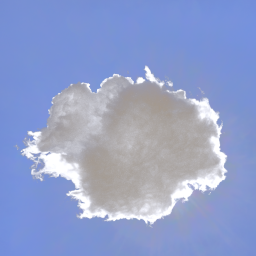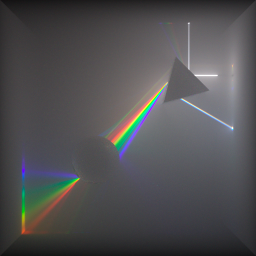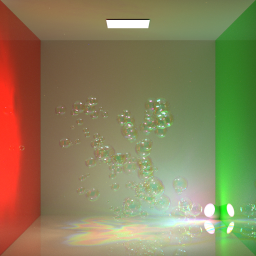Physically-based GPU and CPU ray-tracer emerging on a surface.
- Vertex Connection and Merging algorithm (CPU and GPU);
- Full-spectral rendering in CPU integrators;
- Heterogeneous and scattering medium rendering in path tracing integrators (CPU and GPU);
- Volumetric Bidirectional Path Tracing integrator;
- Variety of BSDFs:
- basic materials - diffuse, plastic, conductor, dielectric;
- additionaal materials - thinfilm, translucent, coating, mirror, coating;
- generic PBR material (WIP);
- Variety of emitters:
- area;
- environment map;
- directional emitter with finite angluar size;
- collimated area lights (lasers);
- Spectral representation of material's properties (colors, index of refractions, etc);
- Normal mapping (CPU only at the moment);
- Thin-film rendering;
- Using OptiX for GPU ray-tracing;
- Most of the code is reused for CPU and GPU integrators.
Several renderings from the ray-tracer. Samples contains showcase for materials, volumetric data rendering, spectral rendering, participating media rendering and SDS (specular-diffuse-specular paths), which are usually tricky thing to render. As well as thin film rendering, collimated emitters, depth of field, and other effects.
More renderings could be found in my Twitter:
This project is a fusion of several my previous projects
- et-engine - the old game engine, which actually was used in several shipped games;
- etx - an extension to the engine, which is used for UI;
- metal-ray-tracer - ray-tracer based on Metal Performance Shaders;
- and one more project is currently located in the private repository.
And the most interesting part is that private repo contains a GPU ray-tracer, which implements Vertex Connection and Merging algorithm on GPU using OptiX (alongside with other integrators, like standard path-tracing and ambient occlusion integrator, both CPU and GPU versions).
So now it is time for that hidden project to emerge on a surface. Releasing it as-is would be too embarrassing for me, because it contains a lot of hacks and code that was required "right now" to make things work. So I would try to rewrite it in a nice way, and probably write some post about it.
Order is a subject to change, but here are main things to do:
- boilerplate code for window, input handling, etc;
- basic boilerplate code for ray-tracing;
- simplest CPU path-tracer;
- OptiX and GPU-related code basics;
- additional code for ray-tracing;
- VCM integrators (CPU and GPU);
- cross-platform, cross-API support; ... maintaining code, adding new features.
This part of the description would be updated during the development of the project, at the moment there is nothing to build here. All updates will be located here: BUILDING.md
This project is GitHub-sponsored by:
Links to the books/papers/publications/resources I've used during the development:








